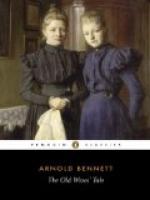She laboriously interested herself, so far as he would allow, in his artistic studies and productions. A back attic on the second floor was now transformed into a studio—a naked apartment which smelt of oil and of damp clay. Often there were traces of clay on the stairs. For working in clay he demanded of his mother a smock, and she made a smock, on the model of a genuine smock which she obtained from a country-woman who sold eggs and butter in the Covered Market. Into the shoulders of the smock she put a week’s fancy-stitching, taking the pattern from an old book of embroidery. One day when he had seen her stitching morn, noon, and afternoon, at the smock, he said, as she rocked idly after supper: “I suppose you haven’t forgotten all about the smock I asked you for, have you, mater?” She knew that he was teasing her; but, while perfectly realizing how foolish she was, she nearly always acted as though his teasing was serious; she picked up the smock again from the sofa. When the smock was finished he examined it intently; then exclaimed with an air of surprise: “By Jove! That’s beautiful! Where did you get this pattern?” He continued to stare at it, smiling in pleasure. He turned over the tattered leaves of the embroidery-book with the same naive, charmed astonishment, and carried the book away to the studio. “I must show that to Swynnerton,” he said. As for her, the epithet ‘beautiful’ seemed a strange epithet to apply to a mere piece of honest stitchery done in a pattern, and a stitch with which she had been familiar all her life. The fact was she understood his ‘art’ less and less. The sole wall decoration of his studio was a Japanese print, which struck her as being entirely preposterous, considered as a picture. She much preferred his own early drawings of moss-roses and picturesque castles—things that he now mercilessly contemned. Later, he discovered her cutting out another smock. “What’s that for?” he inquired. “Well,” she said, “you can’t manage with one smock. What shall you do when that one has to go to the wash?” “Wash!” he repeated vaguely. “There’s no need for it to go to the wash.” “Cyril,” she replied, “don’t try my patience! I was thinking of making you half-a-dozen.” He whistled. “With all that stitching?” he questioned, amazed at the undertaking. “Why not?” she said. In her young days, no seamstress ever made fewer than half-a-dozen of anything, and it was usually a dozen; it was sometimes half-a-dozen dozen. “Well,” he murmured, “you have got a nerve! I’ll say that.” Similar things happened whenever he showed that he was pleased. If he said of a dish, in the local tongue: “I could do a bit of that!” or if he simply smacked his lips over it, she would surfeit him with that dish.
II
On a hot day in August, just before they were to leave Bursley for a month in the Isle of Man, Cyril came home, pale and perspiring, and dropped on to the sofa. He wore a grey alpaca suit, and, except his hair, which in addition to being very untidy was damp with sweat, he was a masterpiece of slim elegance, despite the heat. He blew out great sighs, and rested his head on the antimacassared arm of the sofa.




